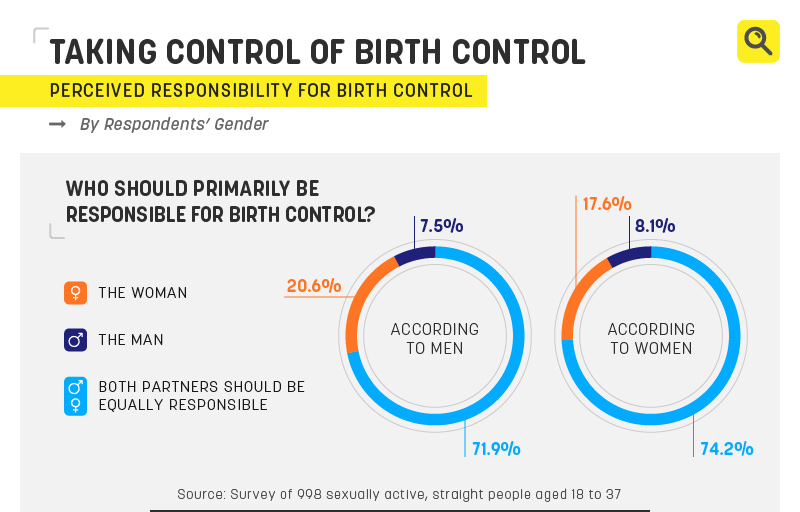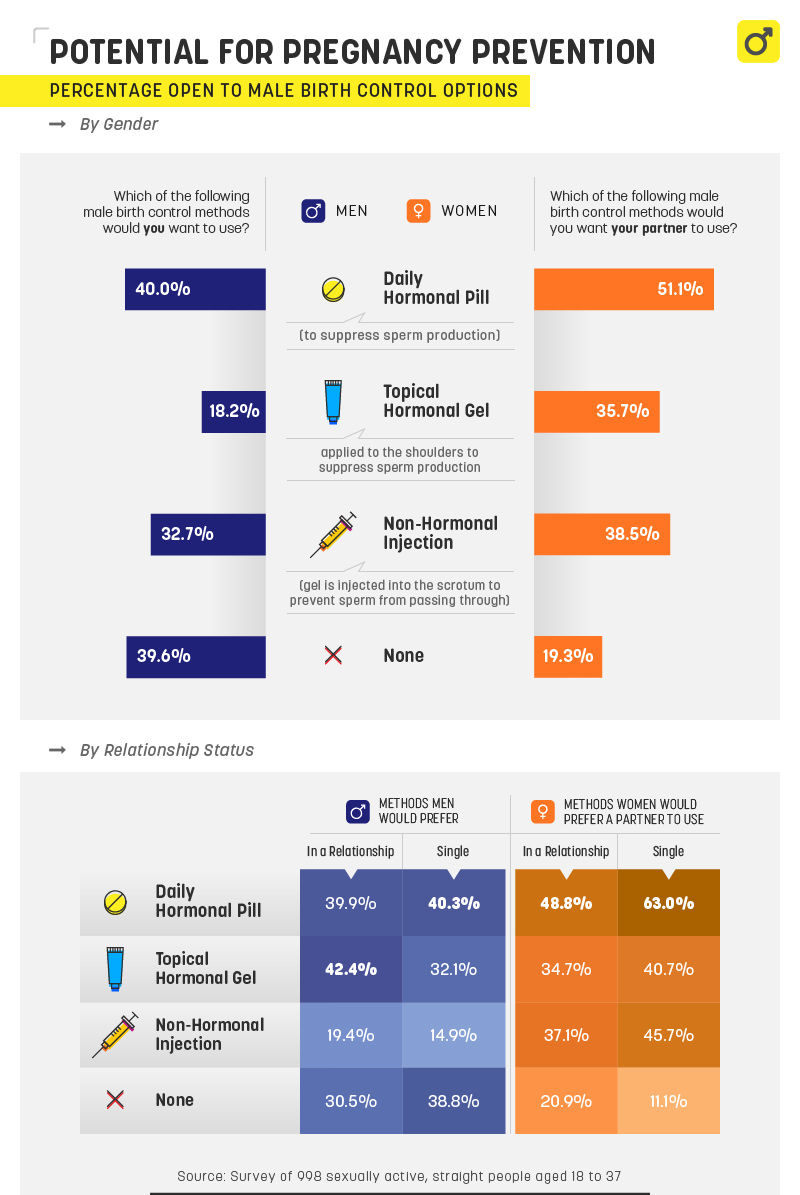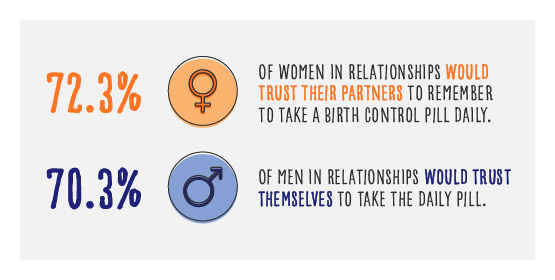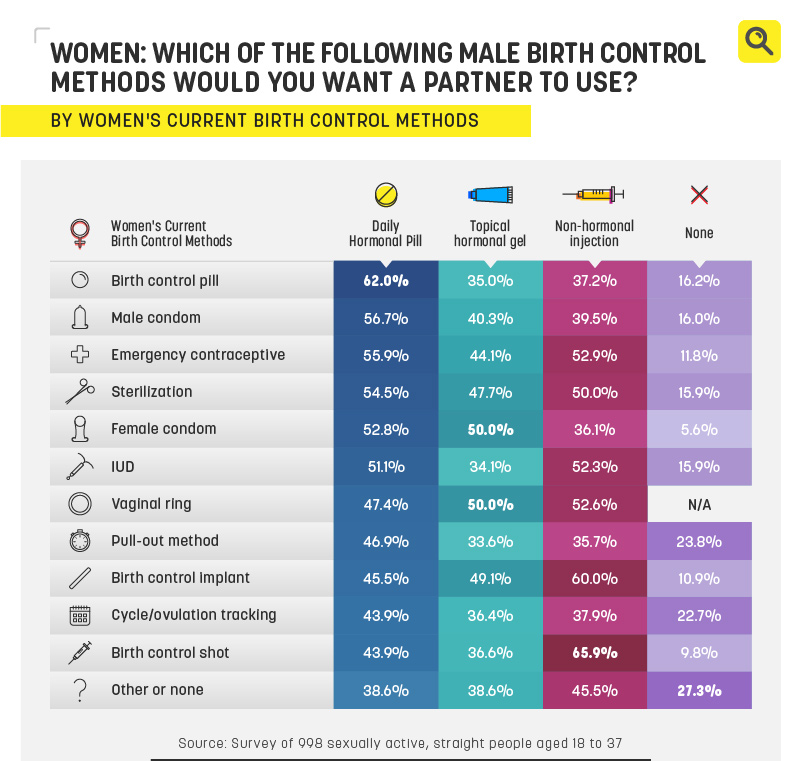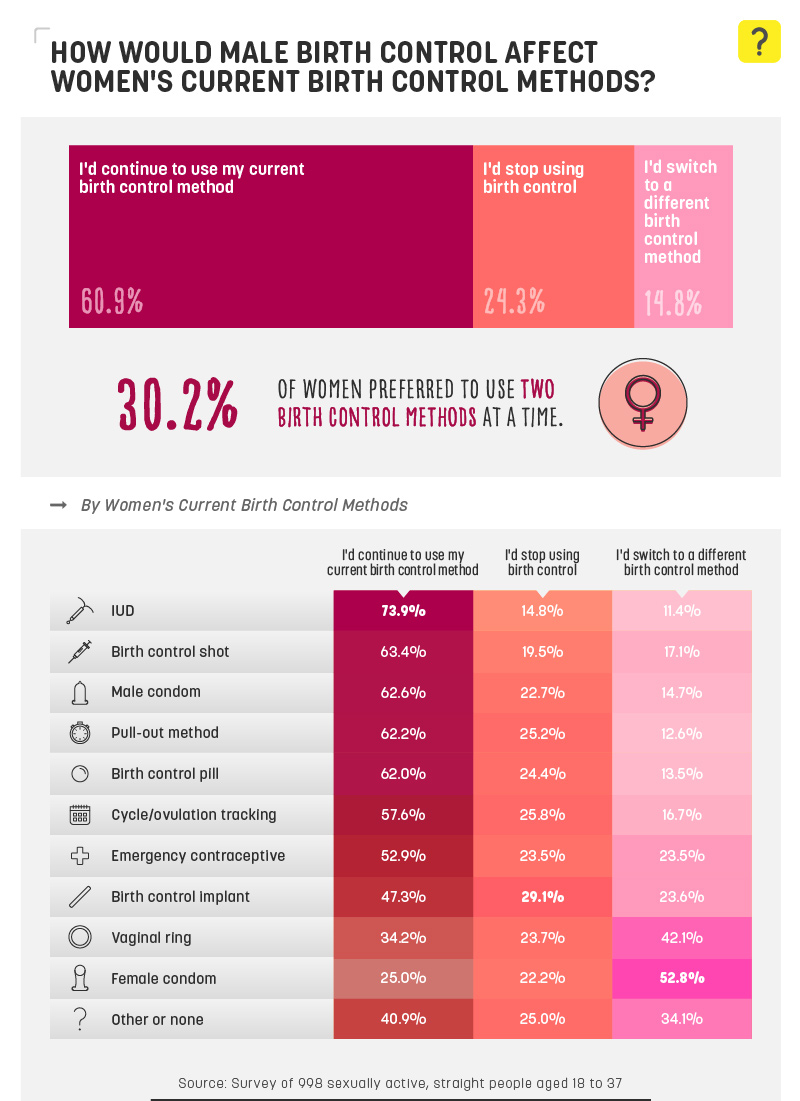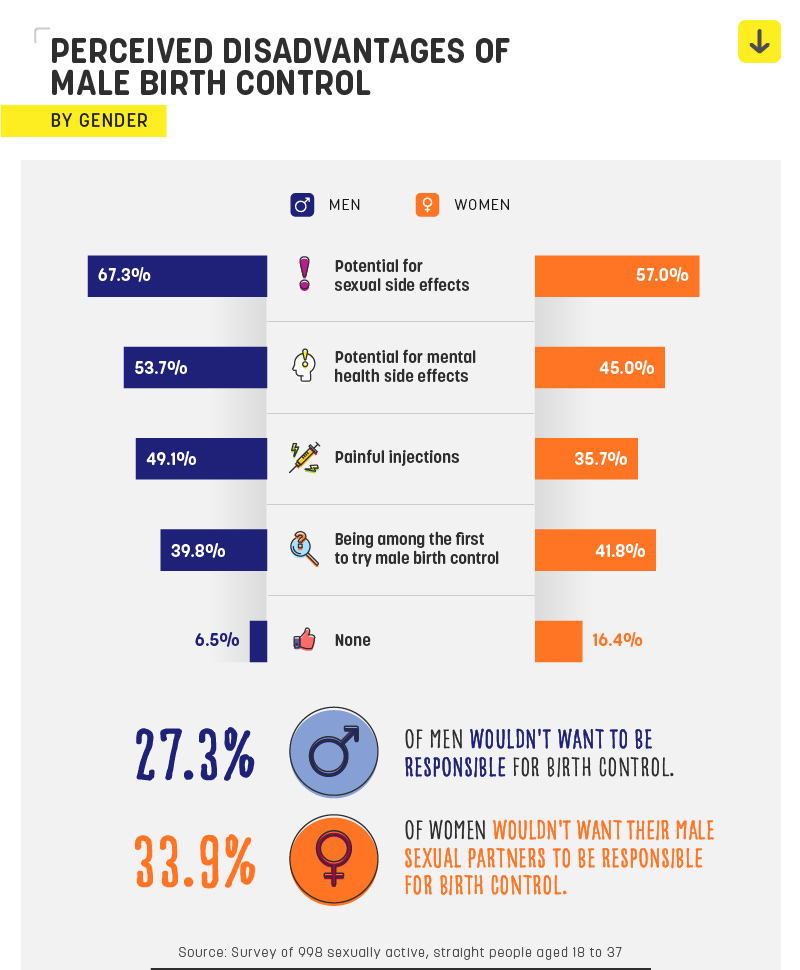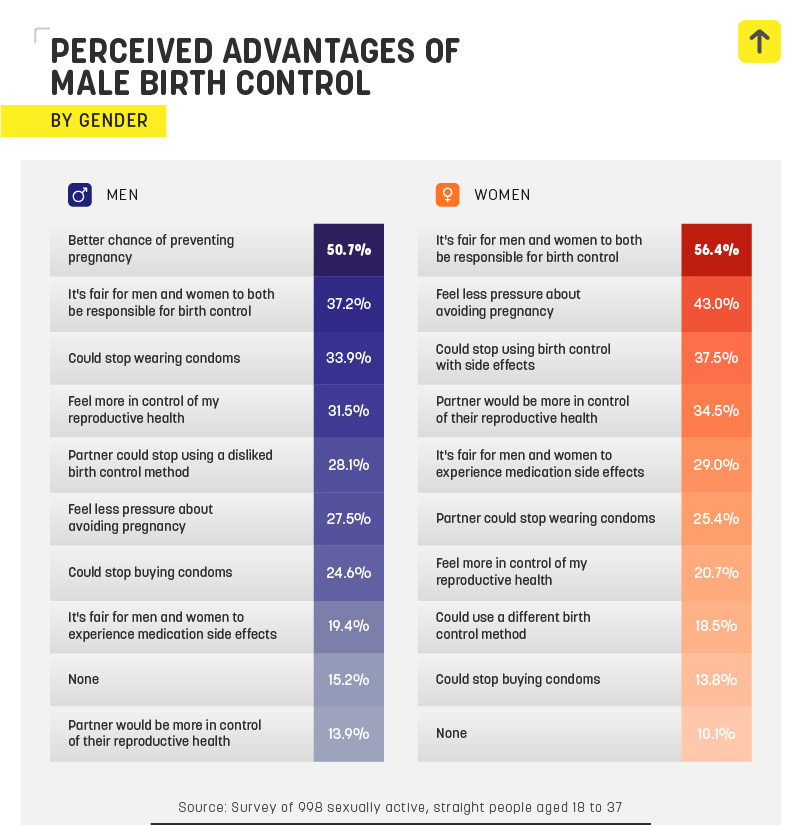In 1960, the birth control pill was approved by the Food and Drug Administration (FDA) for contraceptive use for women. Now, 60 years later, women are still primarily responsible for pregnancy prevention using methods such as the pill, IUDs, and vaginal rings.
Of the various forms of birth control, only several can be used by men: condoms, withdrawal (commonly referred to as the pull-out method), vasectomies, outercourse, and abstinence. However, there are a few forms of male birth control in the clinical trial phase. There are three male birth control methods in development:
- A daily hormonal male contraception pill (called dimethandrolone undecanoate or DMAU) that lowers testosterone levels (a male hormone)
- A topical gel that suppresses sperm production
- A one-time shot that inserts a gel into the vas deferens (the duct which moves sperm to the urethra) to block sperm from traveling outside of the testicles
Adding these three methods would greatly increase the options for men in preventing unwanted pregnancies.
We were interested in seeing how three potential male birth control methods could change the dynamic between male and female sexual partners and how they share the responsibility for their reproductive health. To find out, we surveyed 998 sexually active, straight people aged 18 to 37. Here is what we learned…
Who should be in control of birth control?
When it comes to sharing the responsibility of birth control, nearly 3 in 4 women and about 72% of men believed both sexual partners were equally responsible for using birth control.
There was a greater percentage of men than women who believed the woman should be primarily responsible for birth control, however, possibly because this role has been taken by women for several decades.
A new frontier in preventing pregnancy
With a large percentage of men responding in favor of equality in birth control responsibility, we surveyed participants about which male contraception methods they would prefer to use.
More than 50% of women would be open to having a male sexual partner use a daily birth control pill. Single women were particularly inclined to have a partner who used a daily hormonal pill (63%). Overall, more women were open to a male birth control pill than men.
While 40% of men said they’d use a daily hormonal birth control pill, a similar percentage of male participants wouldn’t be open to any of the three potential options.
“I feel like more options for men would change the dynamic, giving men a little more control and perhaps some additional responsibility in preventing pregnancy,” said a 27-year-old male survey participant from New York.
Injectable male birth control was nearly twice as popular for women in relationships than men in relationships. Since the injection would be administered to a particularly sensitive region, it’s understandable that this option wouldn’t be many men’s first choice for birth control. On the other hand, a one-time injection could have a greater appeal for women whose current birth control options require regular care, such as a daily pill or monthly vaginal ring.
Women’s recommended birth control methods
We also wanted to know if women were more likely to choose birth control options for their partners based on the methods they currently use. When it came to women who used the pill and the shot, they were most likely to choose similar methods for a potential partner.
Over 60% of women who were currently on the pill preferred the male pill to other forms of male birth control. Similarly, nearly 66% of women who got the shot responded that they’d prefer a male partner to use a birth control shot.
A greater percentage of women who used more invasive forms of birth control such as an IUD, vaginal ring, or birth control implant were also more likely to opt for the non-hormonal shot. This could be because a one-time injection might have similar conveniences and long-acting effectiveness to the IUD, ring, and implant.
Changing current approaches to birth control
With more male birth control options available, we surveyed women to see how it would affect their approach to their own birth control practices.
Nearly 61% of women would continue to use their current birth control method if they had a partner using any of the three new male birth control methods. Women may decide to stay loyal to their current birth control methods if they have multiple sexual partners and only some of which use male birth control. Considering 30% of the women said they preferred to use two birth control methods at a time, it’s no wonder they would continue to use their current birth control method even if a partner used male birth control.
Women who had IUDs were less likely to rely on their partner using male birth control. Nearly 3 in 4 women who currently had an IUD would continue to use this form of birth control. This may be because IUDs are 99% effective and last anywhere from three to 12 years. Conversely, over 52% of women who primarily used female condoms would opt to switch to a new form of birth control. They are 79% effective, which makes them less reliable than birth control pills or IUDs, and this may be one reason why female condom users would be more open to making a change.
The cons of male birth control
Current possible methods of male birth control have been stuck in the safety test phase for years, and some studies have been cut short due to severe side effects.
In a trial that included 320 healthy men for a hormonal birth control shot, 20 participants dropped out of the study. Severe negative side effects that occurred during the trial included a case of depression,irregular heartbeats, and erectile dysfunction. Nearly 1,500 adverse side effect events were reported during the study, including more minor effects such as injection site pain, acne, and increased sex drive.
Female birth control methods currently on the market are already known to have multiple negative side effects. The daily hormonal contraceptive pill can cause nausea, headaches, weight gain, changes in eyesight, and much more.
Awareness of the adverse effects of some female birth control methods might make both men and women wary about new male birth control options. The research revealed that 67% of men and 57% of women were concerned about the potential sexual side effects from male birth control. Additionally, over 53% of men and 45 percent of women said they were concerned about the potential mental health side effects.
“I would like the idea if they don’t cause side effects,” said a 33-year-old female survey participant from New Mexico. “Female hormonal birth control causes a lot of side effects, so I don’t trust male hormonal birth control yet. No one should be forced to go through unpleasant health effects if alternatives are available.”
The benefits of birth control
The greatest perceived benefit of male birth control by men was increased pregnancy prevention. Over 31% of men responded they would feel more in control of their reproductive health, and an additional 34% said they would stop wearing condoms.
Over 56% of women believed male birth control would make it fair for both men and women to be responsible for birth control, while less than 38% of men agreed.
“I would be happy to have full control over my own reproduction abilities, but I would be annoyed if I had to visit a doctor’s office often to get shots or prescriptions,” said a 34-year-old male participant from Florida.
Forty-three percent of the women agreed that availability for male birth control options would allow them to feel less pressure about avoiding unwanted pregnancies, while over 27% of men would feel less pressure, too.
A recent study found that if 10% of men interested in male contraceptives used new contraceptive methods, unintended pregnancies would be reduced to 5.2% in the United States.
Conclusion
The female birth control pill changed life as we know it, and it remains to be seen if new male birth control methods will have a similar groundbreaking impact. With over 70% of survey participants responding that both sexual partners should be equally responsible for birth control, three new options for men could shift the dynamics between sexual partners.
Forty percent of men responded they would be willing to try a daily birth control pill. On a grand scale, that could completely redefine how we currently approach birth control. Not only could effective contraception for men increase the level of regulation people have over their reproduction but also it could redistribute the responsibility and freedom between men and women when it comes to sexual health.
Methodology
To conduct our study, we recruited 998 sexually active, straight people aged 18 to 37 living in the U.S. to participate in a survey. The average age was 30.3. The standard deviation for age was 4.8 years. 495 participants were men, and 493 were women. 773 were in a relationship, and 215 were single. The survey was conducted using Amazon’s Mechanical Turk.
Limitations
Since our survey relies solely on the memories and experiences of our participants, some information they reported might have been incomplete, exaggerated, or understated.
This study largely focused on hypothetical situations, so responses may have been different if these male birth control options were currently available for use in the U.S.
This study also may not have included all male birth control options currently being researched and developed.
Findings in this study were neither weighted nor statistically tested.




